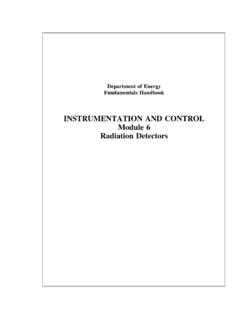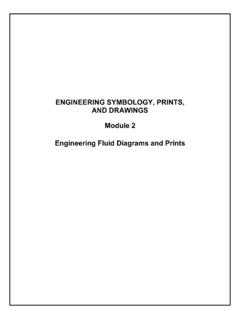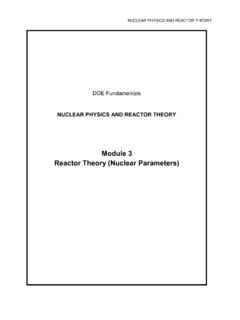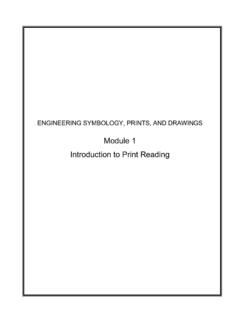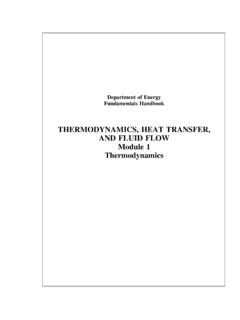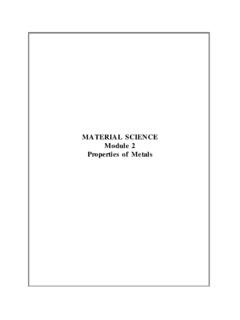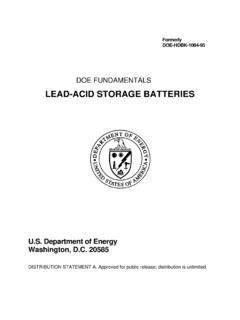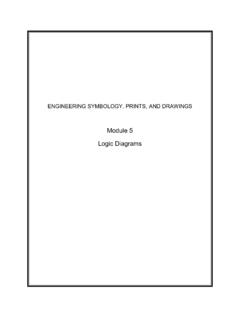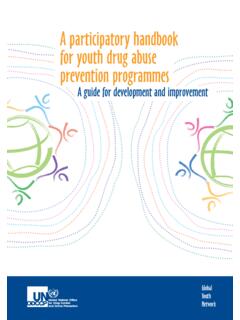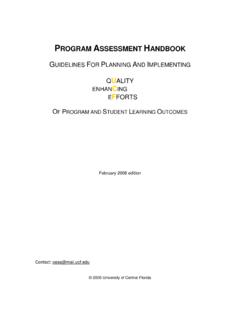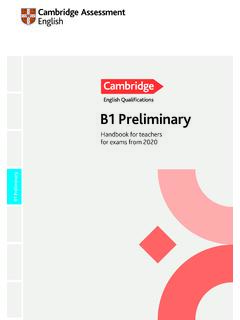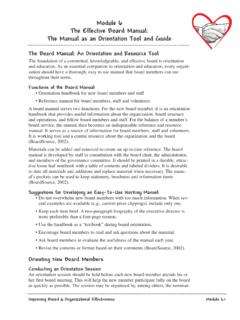Transcription of Training Program Handbook: A Systematic Approach to …
1 DOE handbook DOE-HDBK-1078-94 Reaffirmed June 2014 Supercedes DOE-STD-0102T, TAP-2 Training Program handbook : A Systematic Approach TO Training Department of Energy FSC 6910 Washington, 20585 DISTRIBUTION STATEMENT A. Approved for public release; distribution is unlimited. NOT MEASUREMENT SENSITIVE This document has been reproduced directly from the best available copy. Available to DOE and DOE contractors from the Office of Scientific and Technical Information, Box 62, Oak Ridge, TN 37831; (615)576-8401. Available to the public from the Department of Commerce, Technology Administration, National Technical Information Service, Springfield, VA 22161; (703)487-4650. Order No. DE94018722 DOE HDBK-1078-94 Errata June 2014 Table of Changes Page/Section Change Page vii/1st paragraph DOE O , Personnel Selection, Training , Qualification, and Certification Requirements for DOE Nuclear Facilities and DOE O , Federal Technical Capability.
2 This handbook contains no requirements. Page vii/4th paragraph Brendan M. Burns, PE HS- 32, FORS 1F-045 Department of Energy Washington, D. C. 20585 Phone (202) 586-2671 Facsimile (202) 586-3915 Page 1 This commitment should be made by senior management from the beginning. Managementshould .. Page 6/Section An effective needs analysis involves subject matter experts (SMEs) Page 6/Section Any actions taken and decisions made during the needs analysis should be documented. Page 17/Section Care should be taken when developing and writing learning objectives. Trainees either clearly understand them, or they are of limited use. Related terminal objectives are then written .. Page 17 When writing a terminal objective, consider the Training setting since it has to be balanced against available resources and facility constraints. Page 17/Section However, feedback should be provided.
3 Page 20/Section All terminal objectives for tasks identified for inclusion in the Training Program should now be sequenced Page 20/Section They should be sequenced in a logical progression which takes into account the level of learning necessary to build to the Table of Changes next objective. Page 22/Section 6. List of qualifications, courses of instruction, etc., that have to be completed prior to administration of the performance test Page 22/Section The testing reflects the stated terminal objective. Page 23/Section Key portions of a task should be "perform" items whenever existing facility conditions permit. Page 23/Section .. the entry-level KSAs of the trainee should be considered. Page 24/Section Although a compromise, the conditions and standards applied during Training and testing should be designed to be the .. Page 25/Section Any identified KSAs that are not included in the entry-level requirements should be incorporated into an enabling objective.
4 Page 25/Section scorable items should be clearly defined to distinguish between satisfactory and unsatisfactory performance. Page 26/Section Although at least one test item should be developed for each learning objective, .. Page 26/Section Test items should have answer keys written at this time. Page 26/Section tests are needed prior to implementing the Training Program . Page 29/Section DOE-HDBK-1001-96 Page 37/Section Each learning activity should be analyzed to .. Page 46/Section .. by identifying a clear indication of what will be learned .. Page 54/Section Identify all actions or key points to be evaluated. Each should be important, observable, and measurable; Page 60/Section Program evaluation information should be analyzed before it is used to make changes in Training . Page 60/Section Verify apparent performance discrepancies through discussions .. DOE-HDBK-1078-94 3 Table of Contents FOREWORD.
5 Iv ACRONYMS .. ix INTRODUCTION .. 1 Development of this handbook .. 1 handbook Description .. 1 Management of the Training Program .. 3 ANALYSIS .. 5 Determine Training Needs .. 5 Develop a Valid Task List .. 7 Select Tasks for Training .. 11 Prepare a Task-to- Training Matrix .. 13 Conduct an Analysis of Existing Training Material .. 13 Conduct a Task Analysis .. 14 Application of Job or Task Analysis Information .. 15 Training Development/Changes .. 15 Analysis Checklist .. 15 Key 15 DESIGN .. 17 Write Terminal Objectives .. 17 Develop Training /Evaluation Standards (TESs) .. 20 Develop Test Items .. 25 Construct Tests .. 26 DOE-HDBK-1078-94 4 Write Training Development and Administrative Guide .. 28 Key Considerations .. 31 DEVELOPMENT .. 33 Select Training Methods .. 33 Develop Lesson Plans .. 33 Develop Training Support Material.
6 36 Conduct Training Tryouts .. 39 Key Considerations .. 43 IMPLEMENTATION .. 45 Conduct Training .. 45 Conduct In- Training Evaluation .. 48 Document Training .. 49 Key Considerations .. 51 53 Monitor Indicators .. 53 Analyze Information .. 60 Initiate Corrective Actions .. 62 Key Considerations .. 62 ATTACHMENTS Attachment 1 Training Needs Analysis 67 Attachment 2 Guidelines for writing Task Statements .. 68 Attachment 3 Task Rating System .. 69 Attachment 4 Sample Survey Questionnaire .. 70 Attachment 5 Job Analysis Tabulation .. 82 Attachment 6 Task-to- Training Matrix .. 83 Attachment 7 Task Analysis Data Collection Form .. 84 Attachment 8 Task Worksheet .. 85 DOE-HDBK-1078-94 5 Attachment 9 Training Development/Change Request .. 86 Attachment 10 Analysis Checklist .. 87 Attachment 11 Guidelines for writing Learning 88 Attachment 12 Sample Training Evaluation Standard (TES).
7 104 Attachment 13 Training Evaluation Standards (TESs) Development Worksheet .. 107 Attachment 14 Training Evaluation Standards (TESs) Review Checklist .. 109 Attachment 15 Completed TES Development Worksheet .. 110 Attachment 16 Test Item Formats .. 113 Attachment 17 Sample Test Specification Form for 50-Item General Employee Test .. 116 Attachment 18 Sample Training Development and Administrative Guide .. 117 Attachment 19 Training Methods .. 126 Attachment 20 Sample Lesson Plan Format Classroom .. 129 Attachment 21 Sample Lesson Plan Format OJT .. 131 Attachment 22 Sample Lesson Plan Format Simulator .. 137 Attachment 23 Training Materials Historical Record .. 150 Attachment 24 Instructor Activities .. 151 Attachment 25 Lesson Plan Checklist .. 153 Attachment 26 Training Media .. 155 Attachment 27 Learning Activity Characteristics .. 160 Attachment 28 Existing Material Review Criteria.
8 161 Attachment 29 Sample Instructor Evaluation Form .. 162 Attachment 30 Instructor Supervisor Evaluation Example .. 164 Attachment 31 Indicators of Potential Program Weaknesses .. 165 Attachment 32 Posttraining Questionnaire .. 166 Attachment 33 Posttraining Interview .. 168 Attachment 34 Instructor Lesson Rating Form .. 169 Attachment 35 Sample Course Critique .. 171 Attachment 3 6 Example Employee Training Evaluation .. 172 Attachment 37 Revision Critique Summary .. 173 Attachment 38 Lesson Plan Review Criteria Checklist .. 174 Attachment 39 Instructor Observation Checklist Classroom .. 176 Attachment 40 Training Development Recommendation Checklist .. 180 Attachment 41 Laboratory Instructor Evaluation .. 182 Attachment 42 Instructor Performance Assessment Instrument .. 185 Attachment 43 Supervisor's Posttraining Feedback .. 188 Attachment 44 Simulator Instructor Observation .. 189 Attachment 45 Trainee Posttraining Evaluation.
9 191 Attachment 46 Trainee Cumulative Feedback Evaluation .. 194 DOE-HDBK-1078-94 6 Attachment 47 End-of-Course Training Evaluation .. 196 Attachment 48 Program Evaluation .. 198 FIGURES Figure-1 Criteria for Selecting Tasks for Training .. 12 DOE-HDBK-1078-94 vii FOREWORD This Department of Energy (DOE) handbook , DOE-HDBK-1 078-94, Training Program handbook : A Systematic Approach to Training , describes a Systematic method for establishing and maintaining Training programs that meet the requirements and expectations of DOE Orders DOE O , Personnel Selection, Training , Qualification, and Certification Requirements for DOE Nuclear Facilities and DOE O , Federal Technical Capability. This handbook contains no requirements. The Systematic Approach to Training (SAT) includes five distinct, yet interrelated, phases. These phases include analysis, design, development, implementation, and evaluation.
10 SAT is consistent with other systematically based Training systems such as performance-based Training (PBT), Training system development (TSD), instructional systems development (ISD), and other similar methods. For the purposes of this handbook , SAT and PBT are interchangeable. The Systematic Approach method may also be used in conjunction with other DOE orders and directives that contain personnel Training and qualification requirements. This handbook describes the more classical concept and Approach to systematically establishing Training programs. However, in some cases this classical Approach has proven to be time- and labor-intensive, especially if excessive detail is expected. The risk and complexity associated with performance of a job or the nuclear hazard category of the facility affected may warrant the use of simpler, less detailed alternative methods to achieve results that are both satisfactory and effective.
